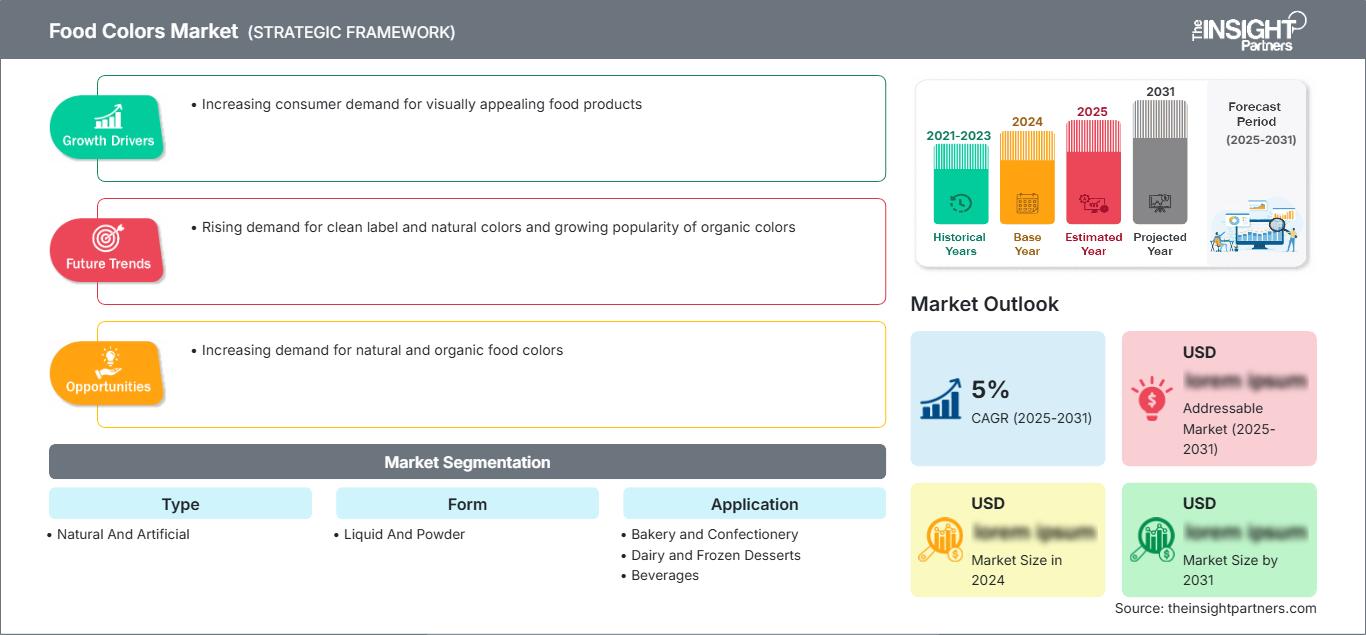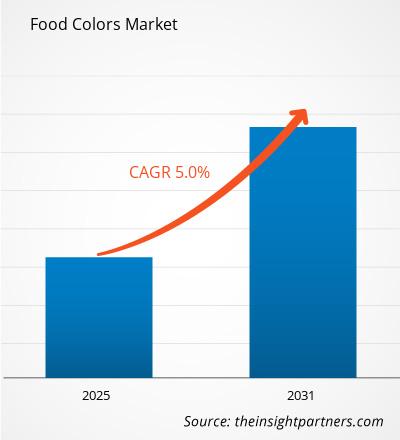Food Colors Market Growth, Trends, and Analysis by 2031
Historic Data: 2021-2023 | Base Year: 2024 | Forecast Period: 2025-2031Coverage: Food Colors Market covers analysis By Type (Natural And Artificial); Form (Liquid And Powder); Application (Bakery and Confectionery, Dairy and Frozen Desserts, Beverages, RTC and RTE Products, Sauces Dressings and Condiments, Meat Poultry and Seafood, and Others), and Geography
- Report Date : Feb 2026
- Report Code : TIPRE00004455
- Category : Food and Beverages
- Status : Upcoming
- Available Report Formats :


- No. of Pages : 150
The Food Colors Market size is expected to reach US$ 6.55 Billion by 2031. The market is anticipated to register a CAGR of 6.7% during 2025-2031. The rising demand for clean label and natural colors and growing popularity of organic colors are likely to remain a key trend in the market.
Food Colors Market Analysis
- The global food colors market is growing at a significant rate, the factors responsible for the same are increased demand for processed and convenience foods, consumer inclination for enhanced taste, texture and appearance, major driving factors for the same include rapid urbanisation, dietary changes and rising disposable income.
- The market is segmented by type, form and application.
- The application areas of food colors embrace a wide range of food products spanning bakery, confectionery, snacks, meat products among others.
- Major players in this sector are focusing on innovative product development, specifically clean label and organic colors keeping the steadfast increase in consumer demands for and long-shelf-life foods indirectly gaining ground for food colors market.
Food Colors Market Overview
- Food colors are additives used to enhance or modify the appearance of food and beverages.
- They can be broadly categorized into natural and synthetic colors. Natural food colors are derived from plant, animal, or mineral sources, such as beetroot, turmeric, carmine, and spirulina.
- These are increasingly popular due to consumer demand for clean-label products.
- Synthetic food colors, also known as artificial colors, are chemically produced and include compounds like Red 40, Yellow 5, and Blue 1. These often provide more vibrant and stable coloration but face scrutiny due to health concerns.
- Food colors come in various forms including liquids, powders, gels, and pastes.
Customize This Report To Suit Your Requirement
You will get customization on any report - free of charge - including parts of this report, or country-level analysis, Excel Data pack, as well as avail great offers and discounts for start-ups & universities
Food Colors Market: Strategic Insights

-
Get Top Key Market Trends of this report.This FREE sample will include data analysis, ranging from market trends to estimates and forecasts.
- The escalating consumer preference for visually appealing food products has emerged as a pivotal force propelling the expansion of the food colors market.
- This trend is multifaceted, influenced by various societal and technological factors.
- The ubiquity of social media platforms, particularly Instagram and Pinterest, has elevated food aesthetics to unprecedented levels, transforming meals into visual experiences that are shared globally.
- This digital showcase of food has heightened consumer expectations, compelling food manufacturers to prioritize the visual appeal of their products.
Increasing demand for natural and organic food colors
- The burgeoning demand for natural and organic food colors represents a pivotal opportunity in the food colors market, driven by a confluence of consumer preferences, regulatory pressures, and industry trends.
- This shift is rooted in growing health consciousness among consumers, who are increasingly wary of synthetic additives and seek products with clean, recognizable ingredients.
- The clean label movement has gained substantial momentum, compelling food manufacturers to reformulate their products using natural colorants derived from fruits, vegetables, and other plant-based sources.
- Regulatory bodies worldwide are tightening restrictions on artificial food additives, further catalyzing the transition towards natural alternatives.
Food Colors Market Report Segmentation Analysis
Key segments that contributed to the derivation of the food colors market analysis are type, form, and application.
- Based on type, the food colors market is divided into natural and artificial.
- Based on form, the food colors market is divided into liquid and powder.
- Based on application, the food colors market is segmented into bakery and confectionery, dairy and frozen desserts, beverages, RTC and RTE products, sauces dressings and condiments, meat poultry and seafood, and others.
Food Colors Market Share Analysis by Geography
- Food Colors Market Report comprises a detailed analysis of five major geographic regions, which includes current and historical market size and forecasts for 2021 to 2031, covering North America, Europe, Asia-Pacific (APAC), Middle East and Africa (MEA), and South & Central America.
- Each region is further sub-segmented into respective countries. This report provides analysis and forecasts of 18+ countries, covering food colors market dynamics such as drivers, trends, and opportunities that are impacting the markets at the regional level.
- Also, the report covers Porter’s Five Forces analysis, which involves the study of major factors that influence the food colors market in these regions.
The regional trends and factors influencing the Food Colors Market throughout the forecast period have been thoroughly explained by the analysts at The Insight Partners. This section also discusses Food Colors Market segments and geography across North America, Europe, Asia Pacific, Middle East and Africa, and South and Central America.
Food Colors Market Report Scope
| Report Attribute | Details |
|---|---|
| Market size in 2024 | US$ XX Billion |
| Market Size by 2031 | US$ 6.55 Billion |
| Global CAGR (2025 - 2031) | 6.7% |
| Historical Data | 2021-2023 |
| Forecast period | 2025-2031 |
| Segments Covered |
By Type
|
| Regions and Countries Covered |
North America
|
| Market leaders and key company profiles |
|
Food Colors Market Players Density: Understanding Its Impact on Business Dynamics
The Food Colors Market is growing rapidly, driven by increasing end-user demand due to factors such as evolving consumer preferences, technological advancements, and greater awareness of the product's benefits. As demand rises, businesses are expanding their offerings, innovating to meet consumer needs, and capitalizing on emerging trends, which further fuels market growth.

- Get the Food Colors Market top key players overview
The food colors market is evaluated by gathering qualitative and quantitative data post primary and secondary research, which includes important corporate publications, association data, and databases. A few of the developments in the food colors market are listed below:
- Phytolon and Ginkgo Bioworks Successfully Achieve First Milestone to Produce Vibrant Natural Food Colors via Two Producing Strains. (Source: Newsletter, Ginkgo Bioworks, Jan 2024)
- Oterra’s New Red and Pink natural color blends the smart ‘plant for plant’ option. (Source: Newsletter, Oterra’s, Jun 2023)
Food Colors Market Report Coverage and Deliverables
The “Food Colors Market Size and Forecast (2021–2031)” report provides a detailed analysis of the market covering below areas:
- Food colors market size and forecast at global, regional, and country levels for all the key market segments covered under the scope
- Food colors market trends as well as market dynamics such as drivers, restraints, and key opportunities
- Detailed PEST/Porter’s Five Forces and SWOT analysis
- Food colors market analysis covering key market trends, global and regional framework, major players, regulations, and recent market developments
- Industry landscape and competition analysis covering market concentration, heat map analysis, prominent players, and recent developments for the food colors market
- Detailed company profiles
Frequently Asked Questions
What is the expected CAGR of the food colors market?
What are the driving factors impacting the global food colors market?
What are the future trends of the food colors market?
Which are the leading players operating in the food colors market?
What are the deliverable formats of the food colors market report?
What are the options available for the customization of this report?
Habi is a seasoned Market Research Analyst with 8 years of experience specializing in the Chemicals and Materials sector, with additional expertise in the Food & Beverages and Consumer Goods industries. He is a Chemical Engineer from Vishwakarma Institute of Technology (VIT) and has developed deep domain knowledge across industrial and specialty chemicals, paints and coatings, paper and packaging, lubricants, and consumer products. Habi’s core competencies include market sizing and forecasting, competitive benchmarking, trend analysis, client engagement, report writing, and team coordination—making him adept at delivering actionable insights and supporting strategic decision-making.
- Historical Analysis (2 Years), Base Year, Forecast (7 Years) with CAGR
- PEST and SWOT Analysis
- Market Size Value / Volume - Global, Regional, Country
- Industry and Competitive Landscape
- Excel Dataset
Related Reports
Testimonials
The Insight Partners' SCADA System Market report is comprehensive, with valuable insights on current trends and future forecasts. The team was highly professional, responsive, and supportive throughout. We are very satisfied and highly recommend their services.
RAN KEDEM Partner, Reali Technologies LTDsI requested a report on a very specific software market and the team produced the report in a few days. The information was very relevant and well presented. I then requested some changes and additions to the report. The team was again very responsive and I got the final report in less than a week.
JEAN-HERVE JENN Chairman, Future AnalyticaWe worked with The Insight Partners for an important market study and forecast. They gave us clear insights into opportunities and risks, which helped shape our plans. Their research was easy to use and based on solid data. It helped us make smart, confident decisions. We highly recommend them.
PIYUSH NAGPAL Sr. Vice President, High Beam GlobalThe Insight Partners delivered insightful, well-structured market research with strong domain expertise. Their team was professional and responsive throughout. The user-friendly website made accessing industry reports seamless. We highly recommend them for reliable, high-quality research services
YUKIHIKO ADACHI CEO, Deep Blue, LLC.This is the first time I have purchased a market report from The Insight Partners.While I was unsure at first, I visited their web site and felt more comfortable to take the risk and purchase a market report.I am completely satisfied with the quality of the report and customer service. I had several questions and comments with the initial report, but after a couple of dialogs over email with their analyst I believe I have a report that I can use as input to our strategic planning process.Thank you so much for taking the extra time and making this a positive experience.I will definitely recommend your service to others and you will be my first call when we need further market data.
JOHN SUZUKI President and Chief Executive Officer, Board Director, BK TechnologiesI wish to appreciate your support and the professionalism you displayed in the course of attending to my request for information regarding to infectious disease IVD market in Nigeria. I appreciate your patience, your guidance, and the fact that you were willing to offer a discount, which eventually made it possible for us to close a deal. I look forward to engaging The Insight Partners in the future, all thanks to the impression you have created in me as a result of this first encounter.
DR CHIJIOKE ONYIA MANAGING DIRECTOR, PineCrest Healthcare Ltd.Reason to Buy
- Informed Decision-Making
- Understanding Market Dynamics
- Competitive Analysis
- Identifying Emerging Markets
- Customer Insights
- Market Forecasts
- Risk Mitigation
- Boosting Operational Efficiency
- Strategic Planning
- Investment Justification
- Tracking Industry Innovations
- Aligning with Regulatory Trends




















 Get Free Sample For
Get Free Sample For